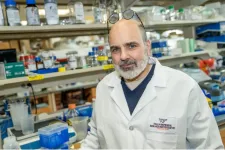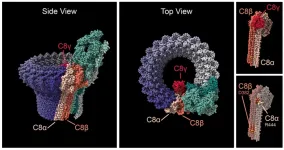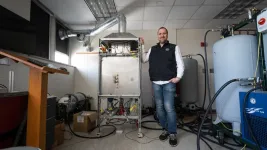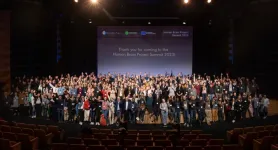(Press-News.org) The human brain begins to assemble itself shortly after conception as a growing number of brain cells connect to create circuits across the brain.
Genes provide the blueprint for construction, but occasionally the blueprint is incomplete, connections aren’t made, and circuits fail — sometimes long before the problem can be recognized, let alone fixed.
That’s the case with DiGeorge syndrome, also called 22q11.2 deletion syndrome, a genetic disorder affecting about one in 3,000 babies. It begins with a deletion of one of two copies of a small number of genes on human chromosome 22, whose cascading effects include cardiovascular problems, craniofacial developmental issues, and as children grow older, autism spectrum disorder and schizophrenia. By the time those symptoms are recognized, it’s long past the opportunity for a medical intervention.
But now Anthony-Samuel LaMantia, a professor at the Fralin Biomedical Research Institute at VTC, has identified a key factor in that chain of events that reflects a fundamental aspect of the initial mistake in the genetic blueprint in individuals with DiGeorge syndrome — and a narrow period in that timeline where help might be possible.
LaMantia, director of the institute’s Center for Neurobiology Research and a faculty member in the College of Science, will study the possibility of exploiting that window of opportunity with a five-year, $3.4 million grant by the Eunice Kennedy Shriver National Institute of Child Health and Human Development, part of the National Institutes of Health.
LaMantia’s research holds the potential for informing new treatment strategies where none currently exists for autism and schizophrenia associated with DiGeorge syndrome. DiGeorge syndrome remains one of the common few genetic syndromes that is associated with a high risk for developing autism and schizophrenia later in life. In addition, understanding the underlying disruption of brain development due to DiGeorge syndrome provides an opportunity to identify how these disorders might arise due to incomplete genetic instructions for building a brain.
LaMantia’s lab, one of a handful in the world working on this problem, has studied DiGeorge syndrome for more than two decades. The lab dives deep into how the brain’s circuits are constructed to develop a precise understanding of the syndrome’s causes.
“I think 20 years of research has provided a foundation for thinking about this disease differently in the clinic,” LaMantia said. “It's a neurodevelopmental disorder and it's disrupting very specific, identifiable steps in development of the brain. And we're really trying to now look at one of the last steps of brain development that we think is the most likely to be accessible to making adjustments without damaging other things.”
LaMantia believes the mitochondria — the power plants of cells — are central to disrupting brain development in DiGeorge syndrome.
In a typically developing brain, the mitochondria in neurons in the cerebral cortex have enough energy to create long-distance connections to other parts of the brain and turn the circuits on and off to ensure everything is working properly.
In DiGeorge syndrome, the mitochondria are oxygen-starved and lack the energy to make necessary connections. The reason for this disruption can be traced to several genes in the region of chromosome 22, which is deleted in DiGeorge syndrome. The imbalance of having only half of the required amount of these genes, the proteins they encode, and the support for mitochondria they provide, underlies a failure to make sufficient numbers of connections during brain development, and a dysfunctional system.
While many of the syndrome’s impacts occur before birth, or before the disease can be diagnosed, the mitochondrial deficit that disrupts making these final connections occurs late enough in brain development to allow for intervention.
“If you're going to fix it, that's probably the only place that is viable to fix it, and without causing other problems in the process,” LaMantia said. “It's fortunate that these are mitochondrial changes, because you can support mitochondria through relatively simple and very safe means, including dietary supplements or more precisely-targeted drugs.”
LaMantia is also a professor in Virginia Tech’s Department of Biological Sciences of the College of Science. Co-investigators include Michael Fox of the Fralin Biomedical Research Institute and professor and director of Virginia Tech’s School of Neuroscience; assistant professor Shannon Farris, research assistant professor Daniel Meechan, research associate professor Gregg Crabtree, and research associate professorThomas Maynard, all of the Fralin Biomedical Research Institute. Allison Tegge, research assistant professor in College of Science’s Department of Statistics, and Andrew Ottens, associate professor of anatomy and neurobiology at Virginia Commonwealth University.
END
Virginia Tech researcher identifies narrow opportunity to address a rare disease linked to autism, schizophrenia
Rare genetic disorder that holds clues to more common diseases to be explored at Fralin Biomedical Research Institute at VTC
2023-04-03
ELSE PRESS RELEASES FROM THIS DATE:
Polyamorous relationships can have as many benefits as monogamous ones, shows research
2023-04-03
Polyamorists face stigma and discrimination in their day-to-day lives, yet research shows that having a romantic relationship with more than one person at a time may offer emotional and physical benefits to all parties.
Monogamy is frequently portrayed as the ideal form of romantic love in many modern societies. From the stories we read as children, to the films and books we consume as adults – we are told that to achieve happiness we need to find our one true soulmate to share the rest of our lives with.
At the same time, states and governments offer financial, legal, and social incentives to married couples. Meanwhile men and women who deviate from these monogamous ...
Aston University establishes new independent investment company
2023-04-02
Aston University is one of eight research intensive universities in the Midlands to establish a new investment company to accelerate the commercialisation of university spinouts and early-stage IP rich businesses in the region.
Midlands Mindforge Limited has been co-founded by Aston University, University of Birmingham, Cranfield University, Keele University, University of Leicester, Loughborough University, University of Nottingham and University of Warwick, collectively Midlands Innovation.
This ambitious, patient capital ...
Outbreak of typhoid on Dutch ship traced to contaminated drinking water
2023-04-02
**Note: the release below is a special early release from the European Congress of Clinical Microbiology & Infectious Diseases (ECCMID 2023, Copenhagen, 15-18 April). Please credit the conference if you use this story**
Embargo: 2301H UK time Saturday 1 April
A large outbreak of typhoid on a ship in the Netherlands has been traced to contaminated water, this year's European Congress of Clinical Microbiology & Infectious Diseases (ECCMID 2023, Copenhagen, 15-18 April) will hear.
Seventy-two cases of typhoid were confirmed in the spring 2022 outbreak on the Liberty Ann, an old cruise ship which was being ...
Extremely rare gene variants point to a potential cause of age-related macular degeneration
2023-04-01
A study from the National Eye Institute (NEI) identified rare genetic variants that could point to one of the general mechanisms driving age-related macular degeneration (AMD), a common cause of vision loss in older adults. The variants generate malformed proteins that alter the stability of the membrane attack complex (MAC), which may drive a chronic inflammatory response in the retina. The findings, published in the journal iScience, point to MAC as a potential therapeutic target to slow or prevent the development of AMD. NEI is part of the National Institutes of Health.
There are many known genetic variants that raise or lower ...
After spinal cord injury, kinesthetic sense helps restore movement, model suggests
2023-04-01
For nearly 50 years, a jawless fish called the lamprey has interested scientists because of its remarkable ability to recover from spinal cord injuries. A new study reveals a possible technique lampreys may use to swim again, despite sparse neural regeneration.
Christina Hamlet of Bucknell University and collaborators, including Jennifer R. Morgan of the Marine Biological Laboratory (MBL), used a mathematical model to demonstrate how lampreys may use body-sensing feedback to regain swimming abilities after spinal injury. The ...
Cookin' with gas: UWO professor earns patent for flameless industrial oven
2023-04-01
Pawel Olszewski, a University of Wisconsin Oshkosh associate mechanical engineering technology professor, recently was granted a U.S. patent for his flameless impingement oven, designed and built in the Teaching and Energy Research Industrial Lab (TERIL) on the Oshkosh campus.
Olszewski began the patent process back in 2019 with WiSys, the Wisconsin-based nonprofit dedicated to helping inventors protect their intellectual property, and received the news of approval in February.
Titled “flameless impingement oven,” the invention is patent number US 11,585,601 ...
This is your brain on everyday life
2023-04-01
A new study from a Washington University researcher offers fresh insights into how the brain goes to great lengths to processes and remember everyday events.
Zachariah Reagh, an assistant professor of psychological and brain sciences in Arts & Sciences at Washington University in St. Louis, and co-author Charan Ranganath of the University of California, Davis, used functional MRI scanners to monitor the brains of subjects watching short videos of scenes that could have come from real life. These included men and women working ...
Iguana stole my cake! and left behind a nasty surprise
2023-04-01
**Note: the release below is a special early release from the European Congress of Clinical Microbiology & Infectious Diseases (ECCMID 2023, Copenhagen, 15-18 April). Please credit the conference if you use this story**
Embargo: 2301H UK time Friday 31 March
**Note – the press release is available in Spanish and Portuguese, see links below**
A 3-year-old girl was infected with an unusual Mycobacterium marinum infection, that developed following an iguana bite while she was on holiday in Costa Rica, report the doctors who treated her ...
Combination therapy a promising option for advanced kidney cancer patients already treated with immunotherapy
2023-04-01
Study Title: Belzutifan plus cabozantinib for patients with advanced clear cell renal cell carcinoma previously treated with immunotherapy: an open-label, single-arm, phase 2 study
Publication: The Lancet Oncology, March 31, 2023, 6:30pm ET, https://www.thelancet.com/journals/lanonc/article/PIIS1470-2045(23)00097-9/fulltext
Dana-Farber Cancer Institute author: Toni K. Choueiri, MD
Summary:
Immunotherapies, such as anti-PD-1 and anti-PD-L1, have become standard first line therapies for patients with advanced renal cell carcinoma (kidney cancer). Most patients, however, eventually experience disease progression, with no consensus on what therapy to use next. In this ...
Final Human Brain Project Summit closes with a vision for the future of digital brain research
2023-04-01
The ten-year European Flagship Human Brain Project (HBP) links brain research with computing and technology in a large-scale, interdisciplinary approach. During the HBP Summit, researchers presented the abundant scientific achievements of the project and the legacy that it will leave for the research community. With the project approaching its conclusion in September 2023, a focal point of the final HBP Summit in Marseille was the discussion of the future of digital brain research.
One of the lasting contributions of the project is the research infrastructure EBRAINS, which provides open access to advanced technologies, tools, data and services for brain research and will ...
LAST 30 PRESS RELEASES:
The Journal of Nuclear Medicine ahead-of-print tip sheet: December 12, 2025
Smarter tools for peering into the microscopic world
Applications open for funding to conduct research in the Kinsey Institute archives
Global measure underestimates the severity of food insecurity
Child survivors of critical illness are missing out on timely follow up care
Risk-based vs annual breast cancer screening / the WISDOM randomized clinical trial
University of Toronto launches Electric Vehicle Innovation Ontario to accelerate advanced EV technologies and build Canada’s innovation advantage
Early relapse predicts poor outcomes in aggressive blood cancer
American College of Lifestyle Medicine applauds two CMS models aligned with lifestyle medicine practice and reimbursement
Clinical trial finds cannabis use not a barrier to quitting nicotine vaping
Supplemental nutrition assistance program policies and food insecurity
Switching immune cells to “night mode” could limit damage after a heart attack, study suggests
URI-based Global RIghts Project report spotlights continued troubling trends in worldwide inhumane treatment
Neutrophils are less aggressive at night, explaining why nighttime heart attacks cause less damage than daytime events
Menopausal hormone therapy may not pose breast cancer risk for women with BRCA mutations
Mobile health tool may improve quality of life for adolescent and young adult breast cancer survivors
Acupuncture may help improve perceived breast cancer-related cognitive difficulties over usual care
Nerve block may reduce opioid use in infants undergoing cleft palate surgery
CRISPR primes goldenberry for fruit bowl fame
Mass General Brigham announces new AI company to accelerate clinical trial screening and patient recruitment
Fat tissue around the heart may contribute to greater heart injury after a heart attack
Jeonbuk National University researcher proposes a proposing a two-stage decision-making framework of lithium governance in Latin America
Chromatin accessibility maps reveal how stem cells drive myelodysplastic progression
Cartilaginous cells regulate growth and blood vessel formation in bones
Plant hormone allows lifelong control of proteins in living animal for first time
Swedish freshwater bacteria give new insights into bacterial evolution
Global measures consistently underestimate food insecurity; one in five who suffer from hunger may go uncounted
Hidden patterns of isolation and segregation found in all American cities
FDA drug trials exclude a widening slice of Americans
Sea reptile’s tooth shows that mosasaurs could live in freshwater
[Press-News.org] Virginia Tech researcher identifies narrow opportunity to address a rare disease linked to autism, schizophreniaRare genetic disorder that holds clues to more common diseases to be explored at Fralin Biomedical Research Institute at VTC




